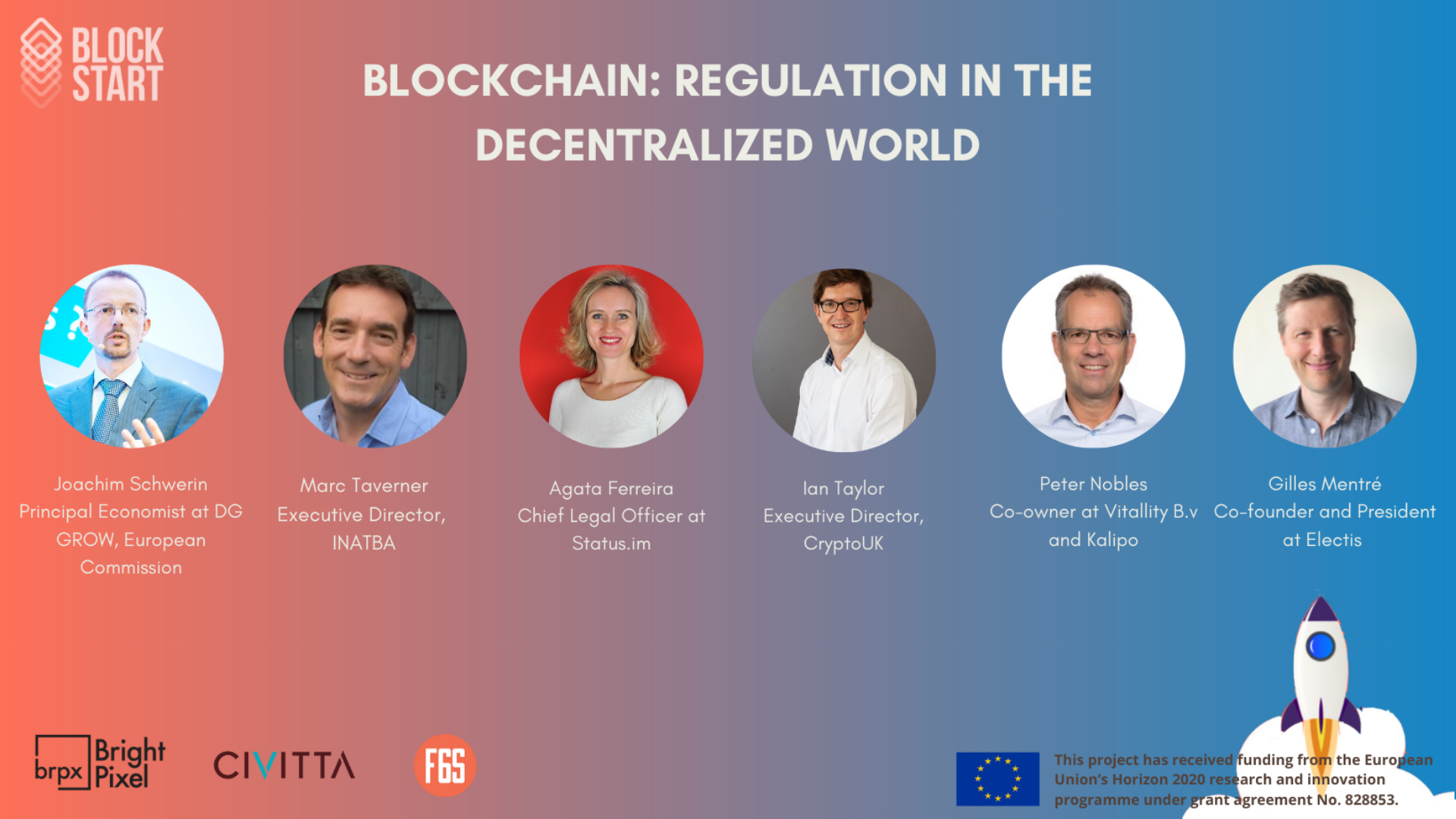On February 24, more than 170 viewers joined BlockStart’s Policy Conference online event, to hear about Blockchain and the regulation in the decentralized world
On the 24th of February, BlockStart invited blockchain industry and policy experts to share their insights on the question of whether top-down regulation and the decentralized essence of blockchain are compatible and how to best regulate the emerging sector. As the day of the event has been marked as the darkest day for Europe in the 21st century, speakers, sharing their support for Ukraine, shed light on how blockchain can be an empowering tool for social good and self-governance. Take a look at the main ideas presented by the distinguished speakers.
Principal Economist at DG GROW, European Commission, Dr Peter SCHWERIN, has set the scene by introducing the European Commission’s (EC) approach to DLT technology. Acknowledging the decentralist approach of blockchain, EC is shifting its approach and accommodating a new paradigm of a bottom-up regulation. It requires openness and flexibility from the regulators, recognizing that it is challenging to see and regulate in advance the rapidly changing industry. According to Dr Schwerin, regulators must move together with the momentum of the space, and limit the regulatory actions to boundary setting, infrastructure provision and guidance. The practical example of this approach is the MiCA regulation proposal (markets in crypto-assets), allowing lightly regulated space for blockchain initiatives and crypto-assets. Comprehensive regulation mostly concerns stable coins and e-money tokens.
Marc TAVERNER, Executive Director of INATBA emphasised that blockchain is presenting new business models and organizational structures, spinning up projects without geographical boundaries, and challenging traditional forms of regulation. Marc proposed a couple of arguments in favour of shifting the regulatory approach from top-down to bottom-up. First, blockchain models can have “inbuilt” regulatory approaches as “preventative” measures to ensure stability and protection to the participants of markets. Secondly, the blockchain industry is motivated to “self-police”. For example, the industry responds to correct problems & limit market risk (e.g. 2016 DAO hack), stolen or hacked funds can be identified, tracked, blocked & eventually returned to owners (e.g. 2016 Bitfinex hack) and, communities monitor activities and rapidly alert faults or hacks to alert users – effective self-police (e.g. Open Sea exploit 2022).
The overview of the UK blockchain industry’s efforts to self-regulate and cooperate with regulators was delivered by Ian TAYLOR, Executive Director of CryptoUK. Ian introduced the organization’s initiatives to establish and nurture productive partnerships between industry participants, legislatures, policymakers, and regulatory agencies and help lawmakers understand the nascent industry and its underlying technologies where needed.
Dr Agata Ferreira, Chief Legal Officer at Status.im; Expert at the EU Blockchain Observatory and Forum and an Advisor for Blockchain for Europe, has emphasised that blockchain technology disrupts conceptual legal regulatory framework in principle. The pace and character of technological development put regulators through the tough test of competence. According to Dr Ferreira, we have a unique opportunity to evaluate our approach to technology and reassess our dominant normative stance in the light of the public interest. Blockchain is a social technology and if regulators would focus only on the financial aspect, they would ignore the paradigm shift and its implications for communities, social values, identity and self-sovereignty.
High-level presentations of the representatives from overarching governmental and industry associations were followed by zooming in into real self-regulation application cases and discussion on the specific decentralized governance solutions.
Gilles Mentre, cofounder and president at Electis, an open-source blockchain-based voting solution, explained how blockchain is enabling bottom-up governance on different levels of society. The e-voting solution is based on an algorithm, which allows confidential voting (so it is impossible to decipher any vote individually), transparency for the final result (sum of voting) and tracking of individual bulletins. Until remote e-voting becomes accepted on the highest level, it can be applied in various levels: municipalities, NGOs, various organisations. For example, a mayor can turn to citizens for questions that might be out of his/her sphere of legacy. Due to established trust, consultations on blockchain have the potential to become a daily practice.
Peter Nobels presented the working principles of DAOs – Decentralized Autonomous Organizations, running on blockchain infrastructure. The main purpose of DAOs is to support communities in governance and coordination. Peter Nobles also shared his vision that nation states’ policymakers could be included in DAO, and by doing so, could create advocacy and ownership for legal sandboxing, generating recommendations for policy adjustments. Further, Peter presented the idea of nation-states functioning as DAOs, with citizens and government members of a DAO.
During the panel discussion, speakers shared their recommendations for policymakers. The main ideas focused on the enhancement of digital skills, education, experimentation, collaboration with entrepreneurs and between regulatory bodies.
If you have not been able to join us on the 24th of February, you can watch the video recording below:
You can also download the full presentation of the event:
